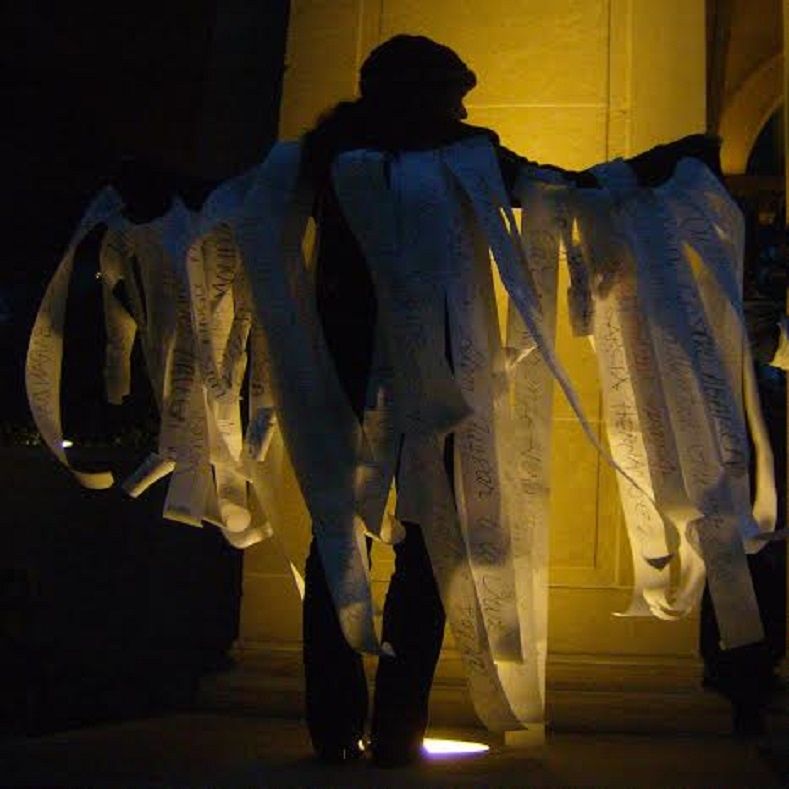“Tribute to the Disappeared” is dedicated to highlighting the case of the disappearance of the Ayotzinapa students and the wider injustices that face marginalized communities.
teleSUR English: Why do you think art is an important way to raise awareness on what is happening in Mexico?
Andrea Arroyo: I believe that art is a fantastic tool to create bridges between communities, and to humanize issues that may seem too distant or too unfamiliar for some. Art is a universal language, “Tribute to the Disappeared” aims to bring international attention to the human rights crisis in Mexico.
This attention may in turn pressure the authorities to begin addressing the issue of the students from Ayotzinapa and the widespread culture of injustice and impunity.
The “Tribute to the Disappeared” workshops and exhibitions have shown me the profound effect art can have on an individual (in terms of healing, creating awareness and creating community.)
Some people may not want to hear a political speech about an issue that may feel “too foreign”, but they may be moved by a poem or a painting in a deeper way that in a sense humanizes the victims, bringing the issue “closer to home”.
teleSUR English: Why do you think people in the U.S. need to know about Ayotzinapa? Do you hope to engage Mexican-Americans specifically?
Andrea Arroyo: Ayotzinapa is a human rights issue first, and we all need to be concerned for the well being of all human beings around the world.
(The U.S.) also needs to know about it because is an international issue, the culture of violence and impunity in Mexico is directly tied to the drug trade, which is unmistakably international.
The production and traffic of drugs generates billions of dollars, is a business fueled by the enormous demand (mostly in the U.S.) and is a business that is tied to thousands of lives lost.
I hope to engage everyone! Mexican-Americans are mostly already aware of the issues at hand, and I think that engaging a diverse audience (and participants) helps create a needed dialogue between communities.
teleSUR English: What might be ties between the struggles in the U.S. and Mexico?
Andrea Arroyo: “Tribute to the Disappeared” honors now not only the men and women disappeared in Mexico, but also other victims of violence and injustice from around the world.
The term “Disappearance” for the project is broad, as I consider many people around the world are also victims of non-literal “disappearances” in the form of discrimination, racism, violence and injustice.
With the U.S., the ties are clear, currently the U.S. is experiencing a surge in racism and a widespread anti-immigrant attitude, so the struggles against discrimination and “invisibility” are shared by many underprivileged communities in this country.
Discrimination and inequality are based in dehumanizing communities that people see as “different” (or that are not even seen, as they may be made “invisible” by the “mainstream”.)

teleSUR English: Tell me about your exhibition for the one year anniversary of the Ayotzinapa disappearances, why did you decide to organize it, what is it about and what do you hope people will take away from it?
Andrea Arroyo: I have been creating work related to human rights issues for a long time, especially about women’s rights for many years.
When the students from the Teachers College in Ayotzinapa were kidnapped last September, I -like many of my fellow Mexicans in NYC- was outraged by the brutality of the case.
I attended an organized demonstration in Union Square and while there, I realized the participants shared the pain and indignation but the community at large was not as engaged as it could be, so I left the demonstration asking myself what I could do to both try to heal my own pain and try to engage the community.
The next weekend, I left my home to attend the demonstration, armed with rolls of paper and markers. On my way there –on the subway-, I wrote each student’s name on a long strip of paper.
Arriving to the demonstration, I pinned the strips to my coat and wore them as “Wings” on my back.I realized the piece had a great impact, generating meaningful connections between people. While the political speeches and actions are valuable, for me, connecting through art proved incredibly moving and efficient, and it got me thinking about using art to engage a larger community.

I spent some time with the parents of the disappeared students in Mexico last month, they are incredible human beings, and their struggle inspires me every day to continue working on this project.
For “Tribute to the Disappeared,” I have gathered images from almost 300 international artists.
The exhibition features around 200 prints of these images that range in style from literal to abstract and are produced by emerging and well-know artists, as well as people from the community. Participants range from 16 to 88 years old.
Just as the Aids Memorial Quilt brought attention to the AIDS epidemic, “Tribute to the Disappeared” aims to bring public attention to another epidemic-the loss of innocent lives lost to the injustice, violence, poverty and displacement.
The goal of the exhibit is to create awareness and foster international solidarity.
I already have another exhibition scheduled for November, and I hope that this project grows even further and becomes a traveling exhibition.
For more information about Arroyo’s exhibitions on the Disappeared. You can visit her Facebook page here.